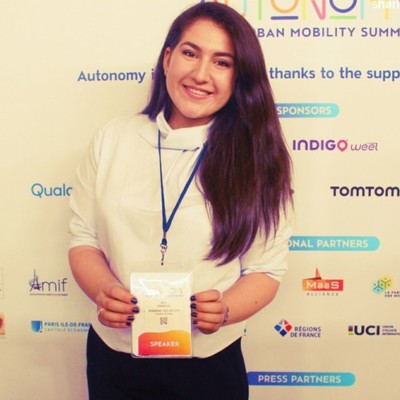

For International Women in Engineering Day 2021, we spoke to a number of selected women to learn more about their journey within the industry. Today, we speak to Anna Craciun, Partnership Manager at Humanising Autonomy and CIHT North West Chair.
It’s very difficult to pinpoint the attraction exactly, as this was a result from a myriad of factors. The first nudge to join the industry occurred during a guest speaker session at University, where I completed a BSc in Geographical Information Science. The versatile workload, scale of projects and well-structured graduate schemes attracted me to the industry. Whilst considering career paths, environmental impact and social values were the two key areas that led me to choose Transport Planning.
I think this is one of the best industries for those who are both theoretically and practically inclined because you get to see projects of different scales develop at different timescales such as a junction upgrade or the design and build of an entirely new relief road. There are so many disciplines that have to work together and interlock to deliver these large transport schemes and having worked on a few of them, such as HS2, the A9 dualling and country wide master plans, it has brought these to life. I started out in fairly technical roles as a GIS Analyst and Transport Planner and then moved towards more people orientated roles in project and programme management as the stakeholder engagement element of my career has enabled me to thrive.
I think this is one of the best industries for those who are both theoretically and practically inclined because you get to see projects of different scales develop at different timescales such as a junction upgrade or the design and build of an entirely new relief road.
As with everything, it’s what you make of it. Whilst the number is still fairly low, I have seen it with my own eyes in the last 5 years in industry how this has evolved, and I truly believe we are on the right track in achieving a more diverse and inclusive workforce. However, this doesn’t mean we just coast along and wait for the numbers to reach equilibrium. Since my Young Professional Chair days back in 2016 for the CIHT North West, the committee and I have supported STEM efforts across Manchester with reaching younger, female audiences and sharing knowledge on the transport sector.
There are challenges in starting any career particularly when it’s not a ‘traditional’ or well defined career path which you learn about in school. I have had to overcome several episodes of ‘imposter’ syndrome, particularly when project managing as a lot of the team members were my seniors in experience and age, however I believe that working through this with a mentor or a supportive colleague can really help.
Whilst the number is still fairly low, I have seen it with my own eyes in the last 5 years in industry how this has evolved, and I truly believe we are on the right track in achieving a more diverse and inclusive workforce.
I was elated to be elected as the new NW chair for the CIHT as I’ve been involved with the CIHT since my first few months as a graduate transport planner, therefore it is wonderful to have the opportunity to support young professionals and enhance our offering to the NW region. We are really lucky as a regional committee since we have that really good balance of not just genders but also experience and fields of interest. Whilst we will continue supporting STEM activities across the region to encourage young females into the industry, we will increase our outreach to those harder to reach communities, outside of the big conurbations and welcome any new members to our network.
Transportation serves the population, which is made up of diverse people of different genders and backgrounds. Therefore, we must make a conscious effort to accommodate for that in the industry and ensure every voice is heard so that we design, plan, and build the most inclusive and accessible transportation possible.
Transportation serves the population...therefore, we must make a conscious effort to accommodate for that in the industry and ensure every voice is heard so that we design, plan, and build the most inclusive and accessible transportation possible.
It’s all about how we portray what we do ourselves as individuals in the industry but also how our employers communicate that and focusing on rewarding and positive projects that enhance people’s lives is a sure-fire way to attract more people to the industry. Ultimately, we are looking to do something rewarding and impactful which is exactly what the Transport sector can offer.
I’ve never really focused on one person in particular as what has kept me motivated the most, has been to follow in the footsteps of leading women in the industry today, such as my peers within my company or in my network.
It’s all about how we portray what we do ourselves as individuals in the industry but also how our employers communicate that and focusing on rewarding and positive projects that enhance people’s lives is a sure-fire way to attract more people to the industry.
Get in touch with CIHT members or councils to get a better understanding of the field and start networking straight away. Networking, CPD and keeping up with transport news are the best way to get a good handle on things and start building a career.

The opinions expressed are those of the author. They do not purport to reflect the opinions or views of the CIHT or its members. Neither the CIHT nor any person acting on their behalf may be held responsible for the use which may be made of the information contained therein.